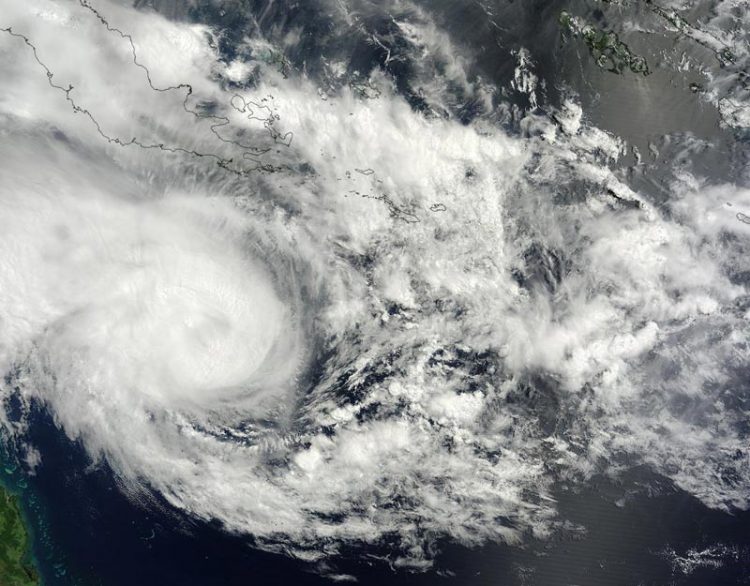NASA sees Tropical Cyclone Nathan moving south and strengthening

NASA's Terra satellite captured this visible image of Tropical Cyclone Nathan east of the Queensland coast on March 16 at 0:00 UTC. Credit: NASA Goddard MODIS Rapid Response
At 0900 UTC (5 a.m. EDT), Tropical cyclone Nathan's maximum sustained winds were near 55 knots (63.2 mph/102 kph) and the storm was consolidating and organizing.
The Joint Typhoon Warning Center (JTWC) forecasters expect Nathan to strengthen to 70 knots in two days.
Nathan was centered near 14.3 south latitude and 150.2 east longitude, about 298 nautical miles east-northeast of Cairns, Australia. It was moving to the southeast at 5 knots (5.7 mph/9.2 kph).
JTWC noted satellite imagery revealed “a slowly-consolidating low-level circulation center slightly to the east of the deepening convection.”
Nathan is moving southeast. The Joint Typhoon Warning center expects Nathan to strengthen to about 70 knots (80.5 mph/120.6 kph) in a couple of days before weakening again and turning back to the west toward Queensland.
Media Contact
All latest news from the category: Earth Sciences
Earth Sciences (also referred to as Geosciences), which deals with basic issues surrounding our planet, plays a vital role in the area of energy and raw materials supply.
Earth Sciences comprises subjects such as geology, geography, geological informatics, paleontology, mineralogy, petrography, crystallography, geophysics, geodesy, glaciology, cartography, photogrammetry, meteorology and seismology, early-warning systems, earthquake research and polar research.
Newest articles

Cost-effective, high-capacity, and cyclable lithium-ion battery cathodes
Charge-recharge cycling of lithium-superrich iron oxide, a cost-effective and high-capacity cathode for new-generation lithium-ion batteries, can be greatly improved by doping with readily available mineral elements. The energy capacity and…

New regulator of eating behaviour identified
The rapidly escalating prevalence of overweight and obesity poses a significant medical challenge worldwide. In addition to people’s changing lifestyles, genetic factors also play a key role in the development…

Harnessing Machine Learning for Breakthroughs with High-Power Lasers
A team of international scientists from Lawrence Livermore National Laboratory (LLNL), Fraunhofer Institute for Laser Technology ILT, and the Extreme Light Infrastructure (ELI) collaborated on an experiment to optimise high-intensity…





















